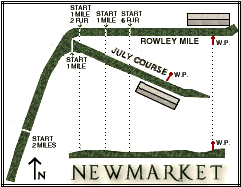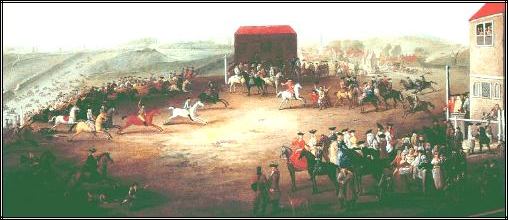|
|
Gazeteer: Race Courses of Great Britain and Ireland
 |
|
Geographic Listing Ordered by County and Month | |
Compiled and Written by Nigel Pullen |
|
|
|
Racing has been held at Newmarket Heath for hundreds of years, possibly as far back as the reign of the Plantagenets, but it was James I who built a palace and stables near the town--Palace House -- later rebuilt and enlarged by Charles II, who had been expertly schooled in horsemanship by the Duke of Newcastle. Charles' patronage of, and participation in races there, gave Newmarket its impetus as a major racing centre. Newmarket consists of two courses, the Rowley Mile, and the July Course. The Rowley Mile is named for "Old Rowley," which was King Charles II's nickname, derived from the name of his favourite hack.
| |
Below: Newmarket racing in 1740 |
|
|
 |
 |
|
|
|
|
First Run: 1809
Month Run: May
Venue: Newmarket, Suffolk, England
Distance: 1 mile (Rowley Mile)
Status:Group 1 for 3 year olds |
|
|
The first running of the 2000 Guineas occurred on 18th April 1809, with Wizard beating seven rivals. The original race, a sweepstakes of 100 guineas each (half forfeit) for three-year-old colts and fillies, attracted 23 subscribers, and was run on the Rowley Mile course. This is a perfectly straight mile, with little rise or fall before "the Bushes," about 2 furlongs from the finish. From that point the course runs downhill for a furlong to "the Dip," the final furlong then being uphill. By accelerating in 'the Dip', races can sometimes be won by using the momentum gained to propel the horse up the final rise.
During the Second World War (1940-1945), the race was run over the Bunbury Mile on the adjoining July Course. |
|
|
|
|
First Run: 1814
Month Run: May
Venue: Newmarket, Suffolk, England
Distance: 1 mile (Rowley Mile)
Status: Group 1 for 3 year old fillies |
|
|
The inaugural running of this race on 28th April 1814 attracted an entry of 10 three-year-old fillies, each paying 100 guineas to enter (half forfeit), which is how the event got its name. The first running went to the filly Charlotte, but unlike the 2000 Guineas, the race was run on the 7 furlong - 178 yards Ditch Mile course at Newmarket; it was transferred to the Rowley Mile at Newmarket in 1873. Like the 2000 Guineas, it was run over the Bunbury Mile on the adjoining July Course between 1940-1945. |
|
|
|
|
First Run: 1876
Month Run: July
Venue: Newmarket, Suffolk, England
Distance: 6 furlongs (July Course)
Status: Group 1 for 3 year olds and upwards |
|
|
Run over the last 6 furlongs of the July Course at Newmarket, this is the season's first Group 1 test for sprinters. The field often consists of established sprinters, matched against three-year-olds that have failed to stay a mile in the 2000 Guineas, and are now dropped back in distance. |
|
|
|
|
First Run: 1870
Month Run: September
Venue: Newmarket, Suffolk, England
Distance: 6 furlongs
Status: Group 1 for 2 year old fillies |
|
|
This race is the end of season target for most of the speedy two-year-olds fillies with classic aspirations for the following spring. It is run over the last six furlongs of the Rowley Mile, and the winner will usually feature prominently as one of the winter favourites for the following seasons 1000 Guineas. The colts' equivalent of this race is the Middle Park Stakes. |
|
|
|
|
First Run: 1839
Month Run: October
Venue: Newmarket, Suffolk, England
Distance: 2 miles 2 furlongs
Status: Handicap for 3 year olds and upwards |
|
|
Once described as a race starting in Cambridgeshire and finishing in Suffolk, a reference to the racing actually crossing the county boundary, the Cesarewitch is a severe stamina test. It was named in honour of the Russian Grand Duke Michael, who donated the original prize money for the event. The two and a quarter mile contest consists of a virtually straight mile, a right hand bend, followed by a daunting mile and quarter straight on the Rowley Mile course, and together with the Cambridgeshire it forms the 'Autumn Double'. In 1857 there was a triple dead-heat for the race, involving Prioress, El Hakim and Queen Bess. In those days the dead-heaters always ran off again to determine an outright winner, and the American-bred Prioress beat El Hakim by a length. |
|
|
|
|
First Run: 1839
Month Run: October
Venue: Newmarket, Suffolk, England
Distance: 1 mile 1 furlong
Status: Handicap for 3 year olds and upwards |
|
|
Run on the straight Rowley Mile course, this event is contested over the rarely run distance of 9 furlongs, and consequently is a race that often sees a particular horse running well year after year; dual winners include Sterope, Prince De Galles and Baronet. With the Cesarewitch it forms the 'Autumn Double', and although these days no horse would contest both events, back in the Victorian times Rosebery (1876), Foxhall (1878) and Plaisanterie (1881) achieved the rare feat of winning both in the same season. The 1903 renewal saw Hackler's Pride land one of the biggest-ever betting coups when taking the prize for the 'Druids Lodge Confederacy', who collected about £10 million (by today's values) in winning bets. |
|
|
|
|
First Run: 1875
Month Run: October
Venue: Newmarket, Suffolk, England
Distance: 7 furlongs
Status: Group 1 for 2 year olds |
|
|
The first running of the Dewhurst Stakes took place at Newmarket on 29th October 1875, with £300 prize money being put up by Mr. Tom Gee, owner of the Dewhurst Stud at Wadhurst in Sussex. Run over the final seven furlongs of the Rowley Mile, the Dewhurst Stakes is a chance for the potential middle distance classic horses of the following season to show their paces. |
|
|
|
|
First Run: 1866
Month Run: October
Venue: Newmarket, Suffolk, England
Distance: 6 furlongs
Status:Group 1 for 2 year olds |
|
|
In the middle of the 19th Century, Yorkshire businessman William Blenkiron invested some of his profits from his London hosiery and haberdashery business, to found the Middle Park Stud at Eltham in Kent. In 1866 Blenkiron donated £1000 to the Jockey Club for a two-year-old race over 6 furlongs at Newmarket, and so the Middle Park Stakes was born on 10th October 1866, with the initial running won by The Rake. This race is now the end of season target for most of the speedy two-year-olds colts with classic aspirations for the following spring. It is run over the last six furlongs of the Rowley Mile, and the winner will usually feature prominently as one of the winter favourites for the following seasons 2000 Guineas. The fillies' equivalent of this race is the Cheveley Park Stakes. |
|
|
|
|
First Run: 1877
Month Run: October
Venue: Newmarket, Suffolk, England
Distance: 1 mile 2 furlongs
Status: Group 1 for 3 year olds and upwards |
|
|
As its name implies, the Champion Stakes invariably attracts a top class field of middle distance horses. It is run over a straight ten furlongs course, which forms an extension of the Rowley Mile. |
|
|

